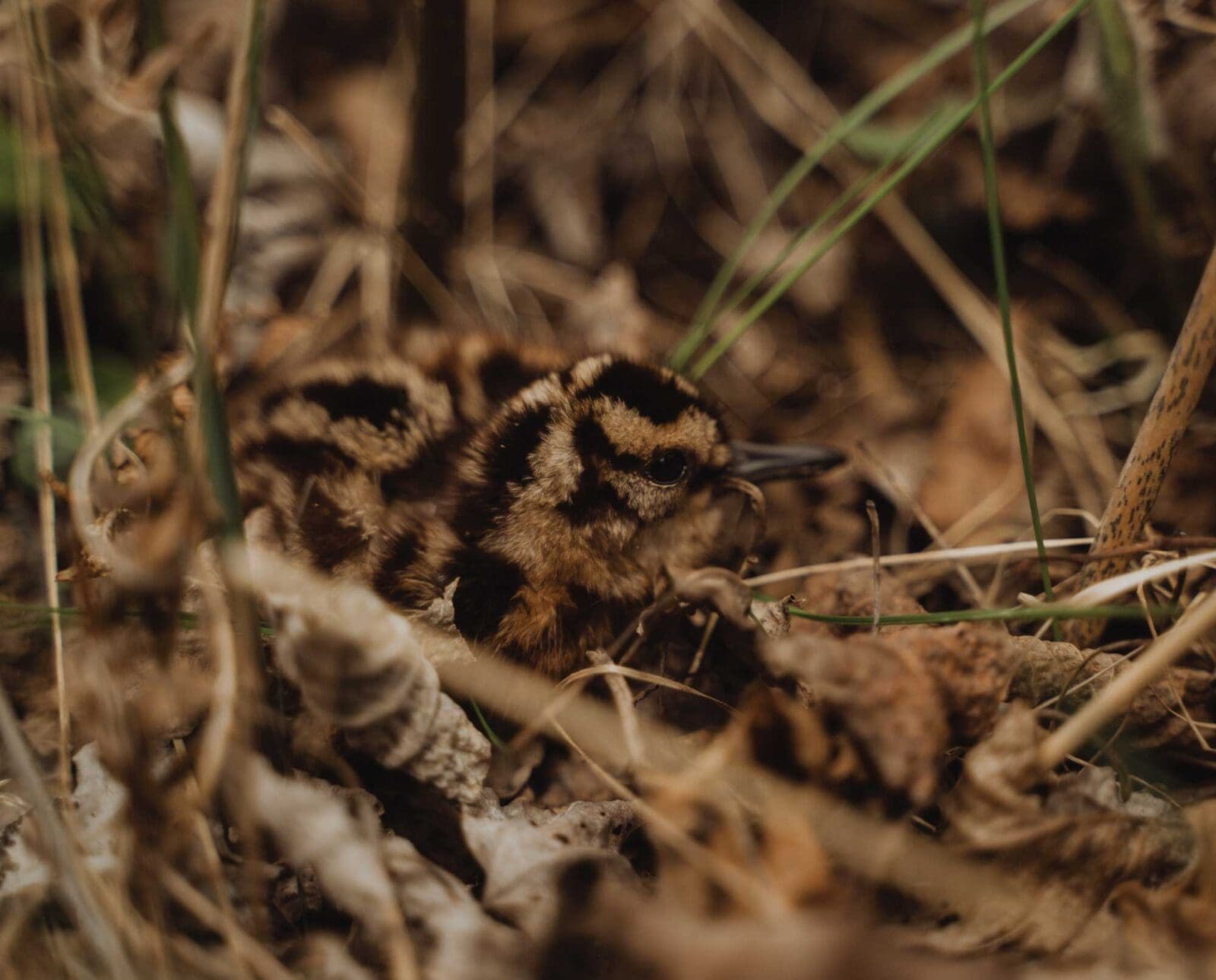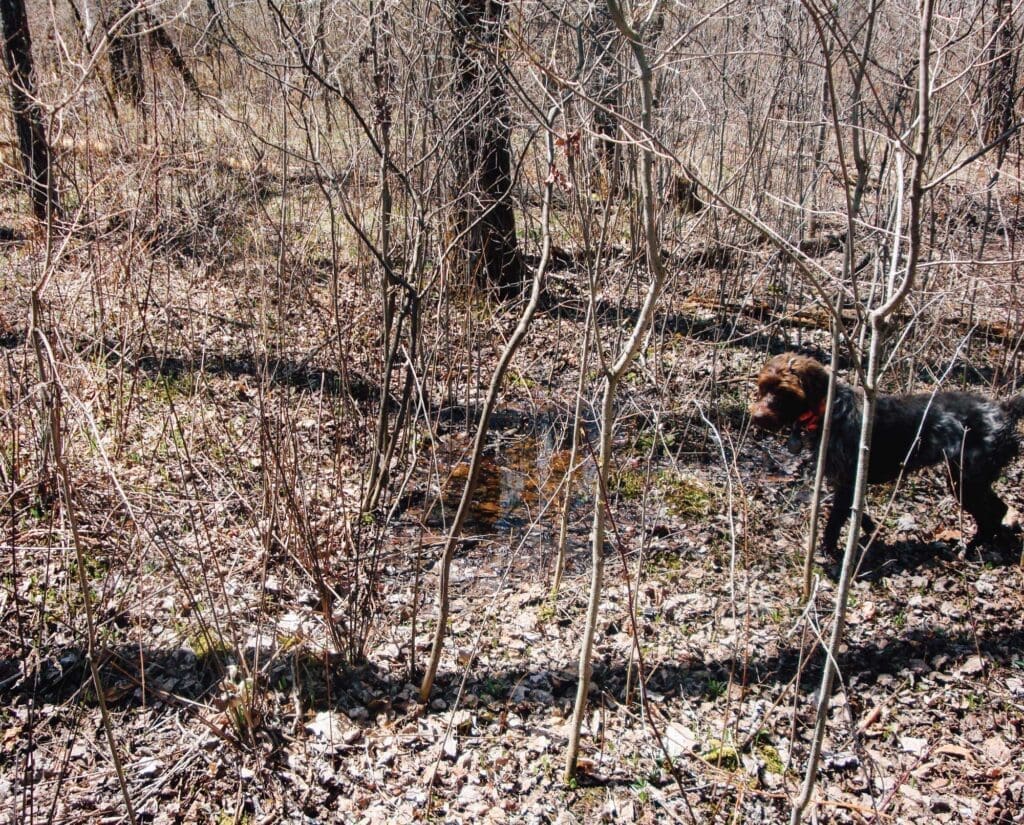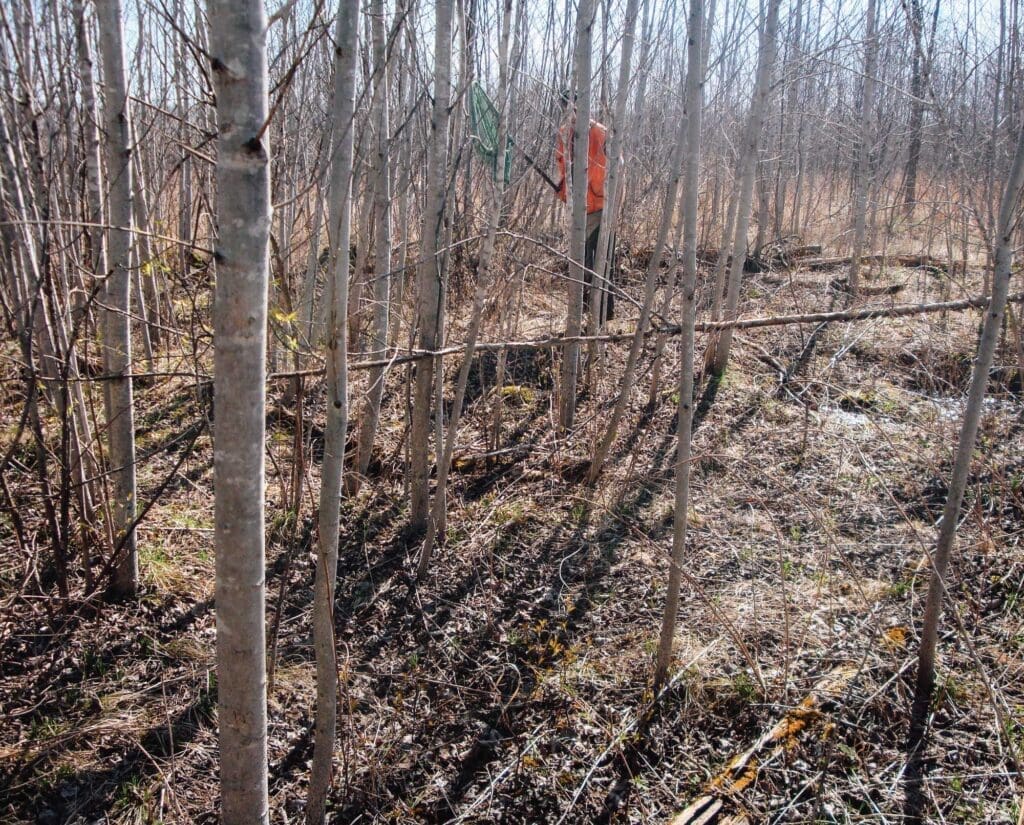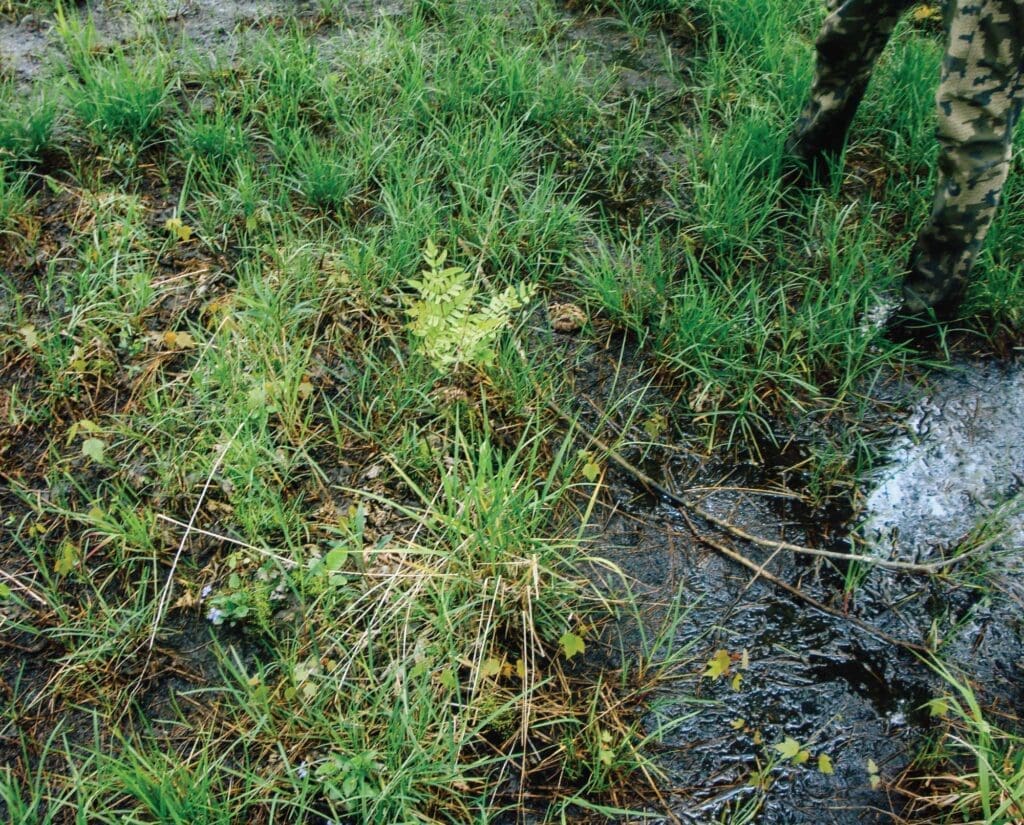Home » Conservation » Your Dog Can Volunteer for Conservation with Your State Agency
Your Dog Can Volunteer for Conservation with Your State Agency

Gabby Zaldumbide is Project Upland's Editor in Chief. Gabby was…
How bird dogs can help wildlife managers collect data on upland birds
It’s the second week of April in Wisconsin. Daily temperatures have just started hitting 60 degrees and t-shirt weather is in full swing. However, if you’re Brian Dhuey, you’re still wearing long sleeves; this morning, you’re taking your pointing dog out to help Wisconsin Department of Natural Resources staff collect data on American woodcock.
In the spring of 2000, Dhuey donned his Muck boots and hiked around marshes, wetlands, and other woodcock breeding areas with his colleague, Sean Strom, an environmental toxicologist. Strom was collecting data for a study on lead accumulation in woodcock and needed to locate hens and broods for his project. Dhuey offered up his German Wirehaired Pointer, Flag, as a method of data collection. Dhuey and Flag hunted woodcock each fall, and she was clued in to their scent and experienced enough not to break her points.
Instead of “hunting” early in the morning, the trio would go out between 10 am and 3 pm on perfect spring days. Because this data collection method can greatly disturb chicks and hens, they made sure they never completed fieldwork on cold or wet days.
“On those days, the hens need to protect their chicks from the elements. You don’t compromise the chicks when it’s sunny, 60 degrees, and not late in the day,” said Dhuey.
“Sometimes we got three broods in one day,” he continued, “When you can handle that many chicks in one day, it’s pretty cool… good dog work is what made that research possible.”
Volunteering your dog for conservation can be very rewarding. Not only does it offer opportunities to train your dog on wild birds in the spring, but you’re helping conserve the very species you enjoy hunting each fall. Get in touch with your state’s game agency to see if any upland bird research is going on near you. If not, consider advocating for wild birds and calling for more research on these at-risk species.

How hunting dogs were selected to volunteer
Luckily for Strom, several of his coworkers were avid upland hunters and owned trained pointing dogs. Knowing he’d have a hell of a time finding and trapping woodcock broods on his own, he recruited those fellow WDNR employees, including Brian Dhuey, a wildlife surveys specialist. It never quite got to the point where they put out a call out to the public because so many of his colleagues volunteered their time and dogs.
Strom specifically chose to work with pointing dogs instead of flushers for several reasons. One reason is that woodcock nests, chicks, and hens are extremely camouflaged. It’s almost impossible to see them on your own, and having a pointing dog around means you can utilize the dog’s sense of smell to locate birds. Additionally, these birds hold very tight in the spring. A well-trained pointing dog who stays very still decreases the risk of injuries to chicks and hens.
“Flushers would have trampled nests,” said Strom. “Pointing dogs were more desirable from a practicality standpoint.”
The breeds selected for volunteering were incidental. “German wirehaired pointers are my dogs,” said Dhuey, “I like their versatile background, although I primarily do upland hunting.” He mentioned how much he enjoys having a dog that both points the bird and follows through on the retrieve.
How wildlife researchers captured pointed woodcock
Strom utilized both live capturing and hunting of woodcock for data collection purposes. In the springtime, Strom captured live woodcock hens and chicks during their flightless period by conducting nest searches. This period lasts for 10 days after woodcock eggs hatch.
After selecting a few properties with breeding woodcock habitat on them, Strom and Dhuey traveled to the site and let the dog down. When Flag would go on point, they moved slowly towards the direction of her nose to try and locate the woodcock nest. Most of the time, the female woodcock would not flush, and Strom would be able to catch her in a hand net. Typically, woodcock hens lay four eggs, so they kept their eyes peeled for four chicks at each nest, too.

“It helps to have two extra people because the woodcock are usually spread out in a feeding pattern,” said Dhuey. “Once they give the alarm call, they all start running, so you need to pick up all the chicks at once.” Needless to say, that sounds like a difficult task to attempt alone.
After being captured, body measurements were taken from each bird. In fact, there’s an equation biologists use to estimate age based on bill length. Blood samples were taken from hens. Additionally, one chick per nest was sacrificed for scientific purposes; this is how they gathered the biotic material necessary to measure the concentration of lead isotopes in nestling bones.
“Those nestlings were accumulating massive amounts of lead,” said Strom.
If the remaining chicks were strong enough, Dhuey, the master bander for Wisconsin, would place a band around their legs. When measurements were collected and the chicks were all banded, the birds would be released.
“I’m authorized to band woodcock, although it’s not an important piece in the management of woodcock ,” said Dhuey. “Wing collections and singing surveys play a much bigger role in managing our woodcock.”
In the fall, Strom and Dhuey would hunt woodcock with steel shot a few days before the season opener. This way, they were able to collect woodcock before lead shot accumulated on public hunting grounds each fall. By doing so, they knew that woodcock were accumulating lead in their bodies outside of hunting seasons, too. Body lengths and lead concentrations were measured for each dead woodcock.

Bird dogs help collect important wildlife research data
“Woodcock are a funny species,” said Strom, “There’s been concerns about their reproductivity and how well the overall woodcock population in the U.S. is doing. This lead issue is another wrinkle in that story.”
Based on what he’s found, Strom isn’t “overly concerned that lead is having a significant impact on woodcock health.” However, he advocates for all bird hunters to switch to nontoxic shot for all their upland hunting.
“This study gave me an appreciation for hunting,” Strom continued. Growing up, his family didn’t hunt, and collecting woodcock data over Flag was his first foray into woodcock habitat and hunting strategies. He mentioned that it really gave him an appreciation for hunting dogs and was impressed by Flag’s ability to pierce through thick habitat.
If you’re interested in volunteering your bird dog for conservation, get connected with your local wildlife biologist. You can ask your local DNR office if they know about any upland studies going on, too. “Ask if you can get involved as a volunteer,” said Dhuey.
Unfortunately, the WDNR doesn’t have any plans to conduct a study like this again. However, Michigan and Minnesota have used hunting dogs to collect wildlife data in the past, and it may be worth checking in with these states to see if they’re collecting data on upland birds anytime soon. I’m sure biologists would find it helpful to have a long list of uplanders to call, ready to donate their pointing dog and skill set for bird conservation.
“I’m an avid woodcock hunter and my dogs have had a lot of woodcock experience,” said Dhuey. “It was nice to take my dogs to work and have a reason to do it.”
Gabby Zaldumbide is Project Upland's Editor in Chief. Gabby was born in Maryland and raised in southern Wisconsin, where she also studied wildlife ecology at the University of Wisconsin-Madison. In 2018, she moved to Gunnison, Colorado to earn her master's in public land management from Western Colorado University. Gabby still lives there today and shares 11 acres with eight dogs, five horses, and three cats. She herds cows for a local rancher on the side.




Lead in birds has been studied for decades, many decades. Read up on eagles, osprey and hawks. Their nests have been harassed the entire time in the name of lead research. Yes they have high concentrations of lead, they always have since the studies began. This is in birds nowhere near bird hunting areas where lead shotshells were in use because of habitat, like Teton and Yellowstone parks. No birds and you can’t hunt there. But the research continues.
I use non-toxic shot often. There is no reason not to. I am not supporting sacrificing woodcock chicks for research that consistently shows birds have lead in their system, no surprises and no new data.
The number one cause of death in laboratory rats is research. I would not encourage participation in destructive testing. On the other hand I would gladly participate in non-destructive testing. The exercise reminds me of bloodletting practices in the name of doing ‘something’. Do something else like weighing them on a digital scale, you know they have lead in their bones, it’s a bird thing.